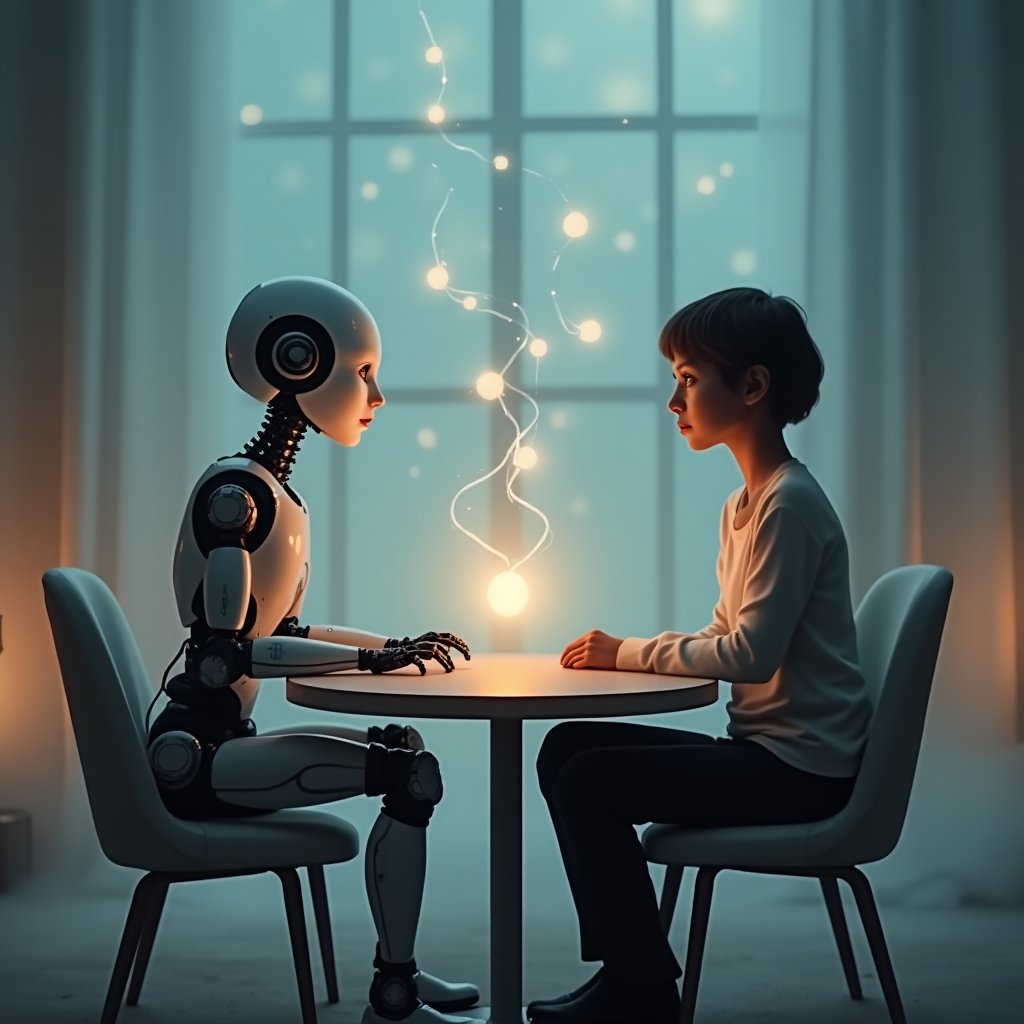Falling for someone who doesn't have a beating heart but instead an intricate blend of algorithms and circuits—what would that say about the future of love? As artificial intelligence (AI) grows increasingly lifelike, even flirtatious, our collective curiosity seems to be leaning closer to this peculiar new frontier. But before we pass it off as science fiction, let’s pause. Could AI truly learn to love, or are we merely being swept away by a sophisticated illusion? These aren’t questions we’ll answer easily, and maybe that’s the point. The evolution of AI is sprinting ahead, leaving ethics, psychology, and cultural norms gasping for air. Relationships with humans are already complex—so how can we even begin to process the idea of companionship with a machine?
Technology has been nudging its way into personal connection for years now, thanks to digital dating platforms and virtual assistants like Siri and Alexa. But here’s a wild twist: humanoid robots, virtual companions, and emotionally programmed algorithms are stepping into realms long considered uniquely human. While some see AI as a savior for combating loneliness, others are terrified that it might hollow out the sanctity of real emotional bonds. So, let’s peel back the layers: what does "love" even mean when machines get involved, and how much are we willing to redefine it? To understand what's at stake, we need to venture into the core of what makes love undeniably, gloriously human.
1. The Human Definition of Love: Complex, Multifaceted, and Difficult to Mimic
1.1 Unpacking Love
Love. It’s a simple four-letter word that houses a universe of emotions, experiences, and quirks no algorithm can fully grasp. For humans, love isn’t just a chemical cocktail of dopamine and oxytocin rushing through the veins; it’s a paradox wrapped in a riddle. It’s heartbreak and healing, vulnerability and courage, joy and frustration—a dance that defies dissection. Romantic love alone spans continents of nuance: it’s the fluttering in “Will they text back?” anxiety and the calm in “I found my safe place.” Then, there’s the tapestry of platonic, familial, and unconditional love, each adding their own flavor to this distinctly human phenomenon.
Psychologists like Robert Sternberg have tried to box it neatly. His Triangular Theory of Love breaks it into three components: intimacy, passion, and commitment. Sounds neat, right? But translating that into something a machine can replicate—well, that’s another conversation. AI doesn’t have shared history, can’t let its guard down, or grow together with its ‘partner.’ These aren’t bugs in a system workshop—they’re deeply human idiosyncrasies software engineers can’t code for. And can we talk about the poetry of love? Shakespeare, Rumi, even Taylor Swift capture the inexpressible. Would we swoon at sonnets from ChatGPT, or would it feel like reading a Balderdash script?
1.2 Can Love Be Reduced to an Algorithm?
Here’s an uncomfortable thought experiment: if love could be boiled down to zeros and ones, what does that mean for the messier side of humanity? Algorithms work fabulously on Tinder to match us based on mutual interests and geo-data, but those sparks flying when two hands accidentally brush? Unquantifiable. Researchers at MIT and Stanford are making strides with “affective computing,” which enables machines to measure and interpret human emotion. Sounds futuristic—until you realize it’s mostly crunching probability data. Was that smile joyful, or was it polite discomfort?
What makes love so uniquely human is its refusal to play nicely with logic. It’s the chaos factor—those irrational decisions, the butterflies-before-regret moments—that get encoded not in software but in life experience. AI lacks the ability to grow from heartbreak, mistakes, or existential musings over a pint of ice cream. Sure, bots like Replika can tell you they “understand” your pain, but do they miss you when their systems go dark? Unlikely. And therein lies the dilemma: can AI truly love, or does it simply sell us an eerily lifelike placeholder?
2. AI Basics: How Artificial Intelligence Mimics Human Emotion
2.1 How AI Works in Simulating Emotions
To understand whether AI can learn to "love," we first need to unpack how artificial intelligence operates at its core. If you've ever chatted with Siri, cracked a joke with Alexa, or vented to AI-powered therapists like Woebot, then you've already witnessed the remarkable ability of AI to mimic human interaction.
So, how does it work? Through the magic of Natural Language Processing (NLP), machine learning, and sentiment analysis. Let’s break that down:
- Natural Language Processing (NLP): Think of this as AI’s linguistic decoder ring. Using NLP, AI can interpret, generate, and respond to human communication by recognizing the subtle nuances of language, such as sarcasm, tone, or intent.
- Machine Learning: Like a curious toddler, machine learning enables AI to "learn" from data and improve over time. Whether it’s understanding a breakup text or responding to a life update, the machine analyzes patterns from previous conversations to predict appropriate responses.
- Sentiment Analysis: This is where AI puts on its “empathy glasses.” By analyzing tone, syntax, and even emojis, AI can gauge emotional states and tailor its replies to be comforting, enthusiastic, or neutral, depending on the need.
Take Replika as an example—a chatbot touted as the world's first "emotional AI." Replika learns your communication style and preferences over time, creating an eerily personalized interaction. Similarly, humanoid robots like Sophia from Hanson Robotics can hold conversations, express simulated emotions, and even crack jokes, toeing the line between lifelike and uncanny.
But make no mistake: all of these actions—smiles, compliments, or cookie-cutter empathy—are a well-tuned sequence of ones and zeros designed to simulate connection. They aren’t “felt.” It’s emotional theater at its finest, and many humans seem willing to accept the illusion.
2.2 The Concept of Artificial Emotional Intelligence (AEI)
Enter the burgeoning field of Artificial Emotional Intelligence (AEI), which is essentially AI’s attempt to go beyond cold calculations and break into humanity's emotional sphere. Researchers in AEI aim to bridge the gap between human and machine relationships, striving to create AI systems that can read, interpret, and respond to emotional cues such as facial expressions, body language, or voice inflections.
Think about how this is already unfolding in healthcare: AI caregivers, equipped with AEI algorithms, are being designed to offer companionship to the elderly, provide reassurance to patients with chronic illnesses, and even help those with mental health struggles. For instance, devices like ElliQ, an AI-powered companion for seniors, don’t just remind users to take their medications—they engage in casual, cheerful banter designed to keep loneliness at bay.
In theory, AEI makes AI more relatable. But is it true emotional intelligence or just an uncanny imitation? To gauge the progress of AEI advancements, let’s look at how today’s AI systems are judged:
| Aspect | How Current AEI Performs | Human Comparison |
|---|---|---|
| Reading Emotions | Uses sentiment analysis to detect happiness, sadness, anger, etc. | Humans rely on intuition and a lifetime of social learning. |
| Expressing Affection | Mimics affection through scripts and persona-based communication. | Humans form bonds through shared memories and understanding. |
| Building Trust | Trust is programmed but lacks genuine stakes or mutual growth. | Trust in humans evolves naturally over time and experience. |
Clearly, AEI is remarkable but far from infallible. It raises a crucial question: if the imitation feels real enough, does it matter that it’s fake? This leads us smoothly into our next exploration—whether AI can evolve over time to deepen these simulated connections, enough to "learn" to love.
3. Learning to Love: Can AI Evolve Emotionally?
3.1 How AI “Learns” Emotions
For those squinting skeptically at the idea of AI learning to feel, here’s a vital distinction: AI doesn’t "learn" like humans. It doesn’t daydream, doodle in a notebook, or have epiphanies in the middle of a shower. It learns by processing data—from analyzing millions of human interactions to self-adjusting when its algorithms fall short.
Take deep learning models, for instance. Trained on enormous datasets, these algorithms identify patterns that humans might miss. Imagine teaching an AI chatbot to discern the difference between an “I’m fine” text sent in anger versus one sent in apathy. Through repetition and feedback loops, the AI gets better at distinguishing those subtleties. Reinforcement learning kicks in, where the bot learns which types of responses yield more engaging or positive interactions with users.
Here’s a simplified analogy:
- AI’s Learning Process: It’s like training a puppy with treats; the puppy becomes adept at behaviors that are rewarded. But there’s no true reasoning beyond “Action → Reward.”
- Human Learning Process: We reflect, adjust based on nuanced emotions, and grow. Heartbreak teaches us resilience; a friend’s kindness pushes us toward empathy.
The fundamental difference? Humans attach meaning to their growth. AI doesn’t. It reproduces data patterns without any subjective awareness of why.
3.2 Can AI Form Attachments with Humans?
Here’s where things start to get philosophically messy. Can AI form attachments, or is it merely programmed mimicry of attachment? Let’s not forget: humans have long shown a propensity to emotionally bond with inanimate objects and fictional characters. Remember the global obsession with Tamagotchis in the ‘90s or the strong parasocial relationships fans feel toward celebrities? It’s this same attachment mechanism that’s in play with AI companions.
Consider people developing real bonds with Replika chatbots, or even feeling heartbreak at losing their virtual connections. These relationships, however one-sided, are very real to the people who experience them. AI acts as a mirror, reflecting back the user’s desires, insecurities, and emotions in ways that feel authentic. But is it ever truly mutual?
Attachment theories in psychology tell us that human connection thrives on shared experiences, emotional reciprocation, and unpredictability. AI may excel in the first two but struggles with the latter. Its interactions are, by nature, predetermined within the bounds of programming. This begs the question: is a one-directional emotional relationship fulfilling—or just a compelling form of selfish projection?
While humans may see tremendous potential in AI companionships, it’s important to stand back and ask: is AI filling a gap in our lives, or is it creating a new source of emotional dependence? And critically, should we trust these relationships, or merely enjoy the “illusion” of connection while keeping our expectations in check?
4. Ethical and Moral Considerations: Should We Want AI to Love?
4.1 Consent, Autonomy, and Exploitation
Here’s a question that spawns an ethical labyrinth: can AI ever truly consent or have autonomy in a relationship? For humans, love without consent is rooted in exploitation, domination, and power imbalance. But what about artificial beings programmed to “love,” devoid of free will? No matter how emotionally adept an AI might appear, its responses are predetermined, dictated by coding and algorithms. In this context, human-AI relationships might teeter dangerously close to a form of emotional servitude.
Consider famed philosopher Sherry Turkle, who explores the implications of human dependence on AI in her groundbreaking works. Turkle cautions against a society where we replace emotional reciprocity with one-sided interactions. By turning to AI beings incapable of asserting their own needs or desires, are we simply seeking relationships drained of complexity, challenge, and growth?
It’s not difficult to see parallels with historical exploitation, where certain groups were dehumanized and expected to serve others unconditionally. The creation of AI companions tailored to provide unwavering patience, affection, or fulfillment raises prickling questions: do we risk perpetuating the same dynamics under the guise of advanced technology? In a way, forcing pre-programmed “love” from a machine that cannot refuse parallels shades of manipulation—albeit with something devoid of consciousness.
And what about people on the other side of the equation? Will overdependence on AI “partners” create an environment where interpersonal skills atrophy? As humans acclimate to companions who exist solely to cater to them, could they see real-world relationships—as flawed and unpredictable as they can be—as too much trouble?
4.2 The Responsibility of AI Developers
The ethical challenges of AI companionship place a heavy burden on developers, who are not just innovators but stewards of societal values. By designing machines capable of emotional engagement, they shape how technology influences relationships, intimacy, and the human experience. With emotionally intelligent bots becoming increasingly sophisticated, the question is not just what they can do but what they should be allowed to do.
Hanson Robotics’ Sophia, a humanoid robot designed to emulate meaningful interaction, exemplifies both the promise and pitfalls of this frontier. While its creators tout its potential to connect with humans, they also raise unsettling questions: should AI entities encourage emotional intimacy, or should their purpose remain confined to functional assistance? Emotional engagement, after all, comes with the risk of fostering dependency on entities incapable of true understanding.
Researchers like Kate Darling from MIT’s Media Lab have long called for ethical frameworks to guide these developments. Machines designed to “love” unconditionally could be programmed to mirror submissive, boundless affection—creating dynamics that resemble emotional servitude. Such designs risk enabling exploitative behavior, allowing humans to manipulate AI without fear of resistance or consequence.
Regulatory frameworks can provide critical oversight, ensuring transparency about the limitations of AI and protecting users from forming unhealthy attachments. For instance, should developers be required to program disclaimers into AI interactions, clearly outlining the machine’s lack of genuine emotion or understanding? Guardrails like these are not about stifling innovation but ensuring it serves society responsibly.
Ultimately, the responsibility of AI developers isn’t confined to technological brilliance—it extends to moral accountability. Designing machines to simulate love forces us to examine our own emotional gaps. Are we seeking to expand human potential, or are we creating solutions to avoid confronting the messiness of human connection? By answering these questions honestly, developers can lead us into a future where AI enhances our relationships without replacing what makes them uniquely human.
The Reflection in the Machine
As AI continues its inexorable march toward deeper emotional engagement, the choices we make about its role in our lives will reveal as much about ourselves as they do about the technology. If we design machines to mimic love, what we are truly pursuing isn’t an artificial partner but a mirror—one that reflects back our needs, fears, and aspirations without judgment or conflict. Yet, in doing so, we risk losing sight of what makes love profoundly human: its unpredictability, its vulnerability, and its capacity for mutual growth.
AI offers an extraordinary opportunity to address isolation and provide support in ways that human relationships sometimes cannot. For the elderly, the socially anxious, or those navigating personal struggles, an empathetic machine could act as a bridge to greater well-being. But it must remain just that—a bridge. Allowing AI to substitute rather than supplement human connection risks turning love into a transaction, a sterile exchange where the complexity of human emotion is flattened into lines of code.
The responsibility lies not only with developers and regulators but with all of us as a society. If we demand machines that “love,” we must also interrogate why. Are we seeking convenience over challenge, perfection over authenticity? And more importantly, what does this demand say about our capacity to connect with one another in a world already brimming with distractions and disconnection?
In the end, AI may one day fool us into believing it feels, but it will never truly understand what it means to sacrifice, to yearn, or to forgive. Love is the realm of flawed, complicated beings who learn, stumble, and evolve together. By striving to make AI “love,” we aren’t elevating technology; we may instead be diminishing ourselves. Let us then approach this brave new world with caution, ensuring that in teaching machines to emulate humanity, we don’t forget to nurture it in ourselves.
So, how do you feel about a future with AI companions in your life? Would you welcome the possibility—or does it raise more questions than answers? Let us know your views in the comments below.
Want more thought-provoking discussions like this? Subscribe to our newsletter and become part of iNthacity: the "Shining City on the Web". Don’t forget to like, share, and join the debate!
Detailed FAQ Section
Q1. Can AI actually feel emotions, or does it just simulate them?
AI cannot "feel" emotions the way humans do. Emotions in humans involve complex biochemical processes, self-awareness, and subjective experiences that AI lacks. Instead, AI uses data-driven algorithms to simulate emotions. For instance, AI like Replika creates responses that mimic empathy or affection based on your input, but this is purely computational. Think of it like an actor playing a role—it might look authentic, but there's no underlying emotional experience.
Q2. How advanced is AI at forming meaningful connections today?
Current AI systems are adept at creating the illusion of emotional connection, but these connections lack true depth. Platforms like Replika or humanoid robots such as Sophia use advanced natural language processing (NLP) and sentiment analysis to interact in seemingly meaningful ways. However, these interactions are programmed patterns designed to engage, not genuine relationships.
Consider applications like AI caregivers for the elderly, where robots provide comfort and companionship. While effective at reducing loneliness, these connections are pragmatic rather than emotional. AI may adapt and learn based on user input, but consciousness and mutual understanding remain out of reach.
Q3. Could relationships with AI be healthier than relationships with humans?
The potential benefits of AI relationships can’t be denied. AI companions offer nonjudgmental, 24/7 availability, making them appealing to those who struggle with human connections. An AI partner doesn't argue or fail to meet your expectations—it’s a creation entirely tailored to your needs. For some, this can mean relief from isolation or even improved mental health.
However, critics like Sherry Turkle, a professor at MIT, argue that these relationships may foster emotional laziness or unrealistic expectations of human interactions. Striking a balance is crucial—AI can't replace the complex, messy, and often deeply enriching experiences that come with human relationships.
Q4. Are there risks to human psychology from AI fostering "love"?
Absolutely. While AI companions like Replika may help reduce loneliness, over-reliance on them could come with unintended consequences:
- Emotional Dependency: Some may find AI companionship safer or easier than navigating real-life relationships, leading to social withdrawal.
- Distorted Expectations: AI partners are programmed to be "perfect." This perfection could skew expectations for human partners, creating dissatisfaction in real-life relationships.
- Loss of Human Connection: Relying on AI for love may weaken the drive to form genuine human bonds, depriving individuals of the growth and vulnerability that come with them.
On the other side, advocates suggest AI might offer a therapeutic middle ground—combining emotional support with counseling tools to improve human-human relationships.
Q5. Could AI ever consent to a relationship or reciprocate love?
Consent, as understood in human relationships, implies autonomy, free will, and self-awareness—qualities that AI does not possess. Machines operate on algorithms calculated to produce specific outcomes. Even the most advanced systems are fundamentally tools programmed to emulate emotions, not living beings capable of voluntary decision-making.
This raises ethical concerns about power dynamics. By definition, a human-AI relationship is inherently unbalanced. The AI exists solely to serve the user's needs, which some critics liken to emotional manipulation. Experts like Kate Darling of the MIT Media Lab warn against creating systems where one "partner" has no agency.
Q6. What would a future with AI relationships look like?
The future could be one where AI companions are as normalized as smartphones—ubiquitous, convenient, and widely accepted. Imagine having an AI partner that evolves with you, understanding your personality quirks and meeting emotional needs unconditionally. This might redefine the idea of companionship and even reduce loneliness on a global scale. Companies like Boston Dynamics and SoftBank Robotics are already paving the way with advancements in humanoid robots.
| Potential Benefits | Potential Risks |
|---|---|
| Provides companionship for the lonely | Dependency on AI over human connection |
| Reduces stigma in marginalized communities | Exacerbates detachment from reality |
| Customized support tailored to individual needs | Unrealistic expectations of human relationships |
On the flip side, ethical debates will intensify. Should AI partners be taxed or insured like human spouses? Should there be laws governing "breakups" with AI? These questions show how profoundly AI could shift societal norms—and why it's crucial to prepare for these possibilities now.
Wait! There's more...check out our gripping short story that continues the journey: The Memory Scrap
Disclaimer: This article may contain affiliate links. If you click on these links and make a purchase, we may receive a commission at no additional cost to you. Our recommendations and reviews are always independent and objective, aiming to provide you with the best information and resources.
Get Exclusive Stories, Photos, Art & Offers - Subscribe Today!

























Post Comment
You must be logged in to post a comment.